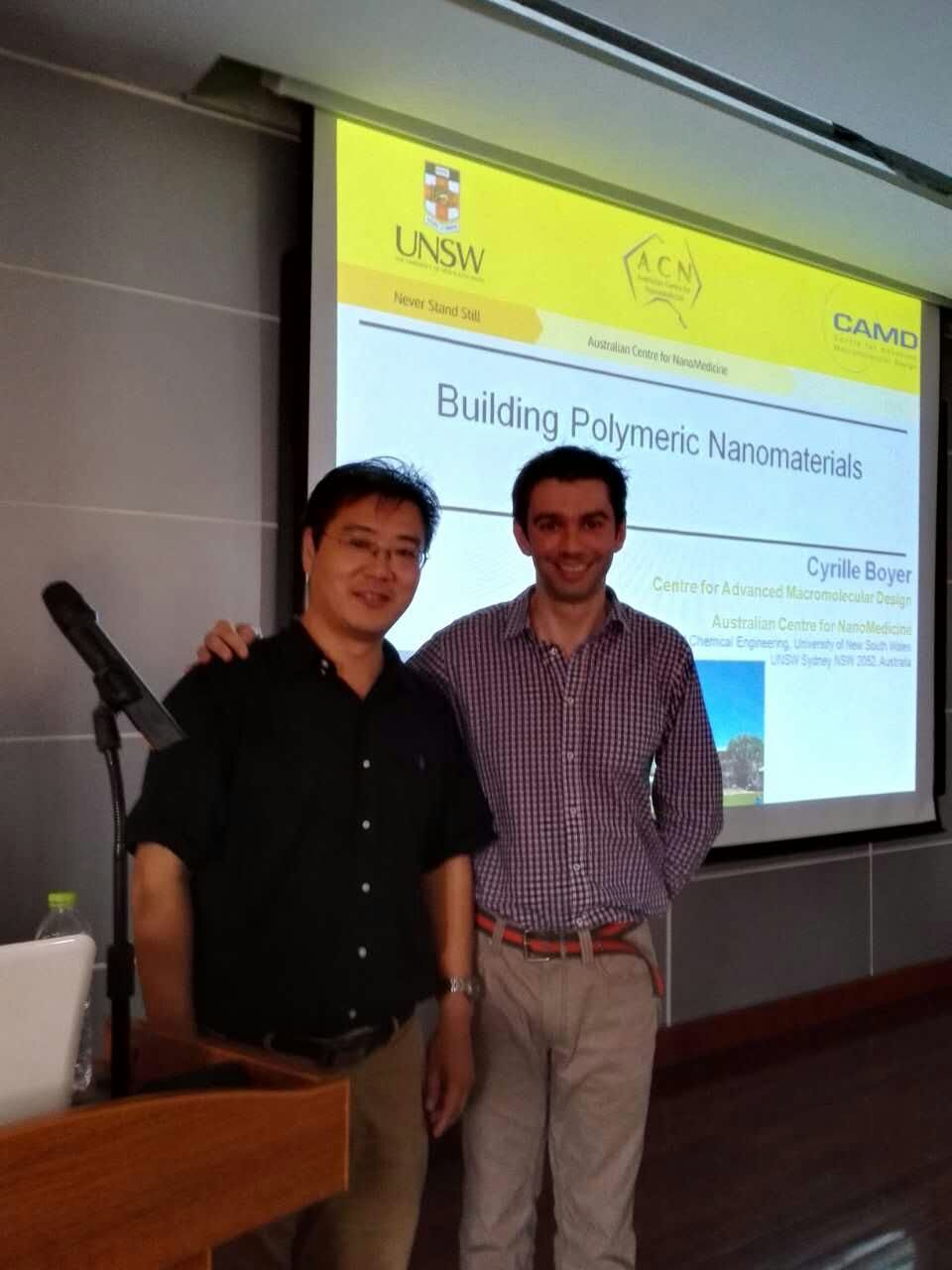2015年9月24日下午3点,澳大利亚新南威尔士大学教授Cyrille Boyer访问团队,并在高分子学院401会议室做了题为“Macromolecular Engineering to NanoEngineering for Advanced Applications”的报告。

报告摘要:Soft core-shell polymeric nanoparticles are an area of great research interest, due to their potential advantages in the sustained and targeted delivery of therapeutic payloads. These systems can offer significant improvements in the temporal and spatial control of drug delivery. In this talk, the development of photoactivated polymerization (PET-RAFT) for the preparation of various polymeric nanoparticles that have been specifically designed to deliver anti-cancer drugs and to image specific tissue, will be discussed. In the first part of this talk, we will present a new polymerization approach, named photoinduced electron transfer - reversible addition fragmentation chain transfer polymerization (PET-RAFT). This technique used photoredox catalysts for the activation and deactivation of polymerization. Such technique was employed for the preparation of polymeric nanoparticle with different shapes (spherical, nanorod, and vesicle) using a facile one-pot polymerization. These different nanoparticle shapes will be tested to deliver a chemotherapy drug and carbon monoxide for the treatment of breast cancer. We will discuss the importance of the nanoparticle shapes in the delivery of therapeutic molecules. The effect of the architecture and the nature of polymers will be correlated with the magnetic properties of these nano-objects. The polymeric shell of these nanomaterials can be designed to conjugate with anti-cancer drugs, and to control their release under specific conditions, such as pH or/and temperature. Finally, I will rapidly mention the use of hybrid inorganic polymeric nanoparticles for the storage of hydrogen. In this part, I will present and discuss on the synthesis of magnesium hydride (MgH2) nanoparticles stabilized and assembled using functional polymer to yield a new generation of nanomaterials with remarkable hydrogen storage properties.
报告人简历: Cyrille Boyer received his Ph-D in polymer chemistry from the University of Montpellier II (awarded in 2006). His Ph-D was in collaboration with Solvay-Solexis and devoted at the synthesis of new graft copolymers using grafting “to”. At the end of his PhD, he undertook an engineer position with Dupont Performance and Elastomers, dealing with the synthesis of original fluorinated elastomers. Later, he joined the Centre for Advanced Macromolecular Design (CAMD) as a senior research fellow. He was working on the synthesis of protein/siRNA-polymer conjugates using RAFT technology. In 2010, he has been appointed as a lecturer in the School of Chemical Engineering and he received an Australian Research Council Fellow (APD-ARC). In 2011, he joined the Australian Centre for NanoMedicine as a project leader to develop new polymeric nanoparticles for drug delivery and gene therapy. The same year, Cyrille started a new research program on the preparation of new hybrid nanoparticles/polymers for hydrogen storage in collaboration with Francois Aguey-Zinsou. In 2012, Cyrille has been promoted Senior Lecturer at the School of Chemical Engineering and he has been awarded an Australian Research Council Fellow-Future Fellowship. In 2012, he also received the Scopus Young Researcher of the Year Award 2012 in the Engineering and Technology. In 2013, Cyrille has been promoted as Associate Professor at the University of New South Wales and received UNSW Research Excellence Award and NSW innovation award in 2014. Cyrille has published over 130 research articles, 4 granted patents and 4 submitted patents, which have generated over 5000 citations. Cyrille’s research interests mainly cover the preparation of well-defined polymeric nanoparticles for delivery of therapeutic molecules (including chemotherapy drugs, siRNA and nitric oxide), hybrid organic-inorganic nanoparticles for imaging and energy storage and macromolecular design.